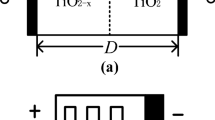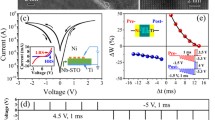Abstract
The traditional Pavlov associative memory circuit includes reinforcement and extinction in the classical conditioned reflex. In fact, in addition to the reinforcement and extinction, classical conditioned reflex is accompanied by several higher-order effects. The blocking process is a very common phenomenon in organisms, and it is one of the higher-order effects. In this paper, a circuit based on memristor is designed to realize blocking based on Pavlov’s associative memory. First of all, the circuit constructs a complete neural network circuit. The input neuron circuit composed of CMOS and other devices replaces the DC signal source and can generate pulse signals, making the circuit more bionic. Secondly, advanced neural activities such as learning memory, associative memory, and forgetting are realized. At the same time, the blocking process was realized on the basis of classical conditioned reflex, and the circuit successfully simulated the appearance and disappearance of the blocking phenomenon. Finally, the circuit simulation was carried out through PSPICE, and the simulation results proved the correctness of the circuit design.













Similar content being viewed by others
References
Hawkins RD, Kandel ER (1984) Is there a cell-biological alphabet for simple forms of learning. Psychol Rev 91(3):375–391
Pavlov I (2010) Conditional reflexes: an investigation of the physiological activity of the cerebral cortex. Ann Neuro Sci 17(3):136–141
Campbell BA, Church RM (1969) Punishment and aversive behavior. Appleton-Century-Crofts, New York, 270–272
Rescorla R, Wagner A (1972) A theory of Pavlovian conditioning: Variations in the effectiveness of reinforcement and nonreinforcement. Classical conditioning: current research and theory, 64–99
Shang M, Wang X (2020) A memristor-based circuit design for generalization and differentiation on pavlov associative memory. Neurocomputing 389:18–26
Shang M, Wang X, Li M (2020) A memristor-based generalization and differentiation circuit design and the application in recognition. In: 2020 39th Chinese Control Conference (CCC) 7206–7211
Chua L (1971) Memristor-the missing circuit element. IEEE Trans Inf Theory 18(5):507–519
Chua LO, Kang SM (1976) Memristive devices and systems. Proc IEEE 64(2):209–223
Strukov DB, Snider GS, Stewart DR, Williams (2009) The missing memristor found. Nature 459(7250):1154–1154
Biolek Z, Biolek D, Biolkova V (2009) Spice model of memristor with nonlinear dopant drift. Radioengineering 18(2):210–214
Kvatinsky S, Friedman EG, Kolodny A, Weiser UC (2013) Team: Threshold adaptive memristor model. IEEE Trans Circuits Syst I Reg Papers 60(1):211–221
Kvatinsky S, Ramadan M, Friedman EG, Kolodny A (2015) Vteam: a general model for voltage-controlled memristors. IEEE Trans Circ Syst II 62(8):786–790
Zeng Z, Wen S, Yang L (2018) A full-function pavlov associative memory implementation with memristance changing circuit. Neurocomputing 272:513–519
Junsangsri P, Lombardi F (2013) Design of a hybrid memory cell using memristance and ambipolarity. IEEE Trans Nanotechnol 12(1):71–80
Yang Z, Wang X, Yi L, Friedman EG (2017) Memristive model for synaptic circuits. IEEE Trans Circ Syst II 64(99):767–771
Deng Q, Wang C, Yang L (2020) Four-wing hidden attractors with one stable equilibrium point. Int J Bifurcation Chaos 30(6):2050086
Xie WL, Wang CH, Lin HR (2021) A fractional-order multistable locally active memristor and its chaotic system with transient transition, state jump. Nonlinear Dyn 104(4):4523–4541
Deng J, Zhou M, Wang C, Wang S, Xu C (2021) Image segmentation encryption algorithm with chaotic sequence generation participated by cipher and multi-feedback loops. Multimed Tools Appl 80(8):13821–13840
Zeng J, Wang C (2021) A novel hyperchaotic image encryption system based on particle swarm optimization algorithm and cellular automata. Secur Commun Netw 2021(5):1–15
Xu C, Sun J, Wang C (2020) An image encryption algorithm based on random walk and hyperchaotic systems. Int J Bifurcation Chaos 30(04):2050060
Julien B, Snider GS, Kuekes PJ, Joshua JY, Stewart DR, R Stanley W (2018) “memristive” switches enable “stateful” logic operations via material implication. Nature 464(7290):873–876
Guckert L, Swartzlander EE (2017) Mad gates memristor logic design using driver circuitry. IEEE Trans Circ Syst II 64(2):171–175
Dong Z, Yufei HE, Hu X, Qi D, Duan S (2019) A flexible memristor-based logic unit circuit and its network integration for boolean logic implementation. IET Nanodielectrics 2(2):61–69
Wen S, Wei H, Zeng Z, Huang T (2018) Memristive fully convolutional network: an accurate hardware image-segmentor in deep learning. IEEE Trans Emerg Topics Comput Intell 2(5):324–334
Dong Z, Lai CS, Qi D, Xu Z, Li C, Duan S (2018) A general memristor-based pulse coupled neural network with variable linking coefficient for multi-focus image fusion. Neurocomputing 308(SEP.25):172–183
Hong Q, Zhao L, Wang X (2018) Novel circuit designs of memristor synapse and neuron. Neurocomputing 330(22):11–16
Lin H, Wang C, Sun Y, Yao W (2020) Firing multistability in a locally active memristive neuron model. Nonlinear Dyn 100(4):3667–3683
Lin H, Wang C, Hong Q, Sun Y (2020) A multi-stable memristor and its application in a neural network. IEEE Trans Circ Syst II 67(12):3472–3476
Yao W, Wang C, Sun Y, Zhou C, Lin H (2020) Exponential multistability of memristive cohen-grossberg neural networks with stochastic parameter perturbations. Appl Math Comput 386:125483
Zhou C, Wang C, Sun Y, Yao W (2020) Weighted sum synchronization of memristive coupled neural networks. Neurocomputing 403:211–223
Lin H, Wang C, Yao W, Tan Y (2020) Chaotic dynamics in a neural network with different types of external stimuli. Commun Nonlinear Sci Numer Simul 90:105390
Chen L, Li C, Wang X, Duan S (2013) Associate learning and correcting in a memristive neural network. Neural Comput Appl 22(6):1071–1076
Suh D, Choi Y, Bae G, Park W (2015) An associative memory device using a magnetic tunnel junction. In: Magnetics Conference, pp. 1–1
Li Y, Xu L, Zhong YP, Zhou YX, Zhong SJ, Hu YZ, Chua LO, Miao XS (2015) Associative learning with temporal contiguity in a memristive circuit for large-scale neuromorphic networks. Adv Electron Mater 1(8):1500125
Wang L, Li H, Duan S, Huang T, Wang H (2016) Pavlov associative memory in a memristive neural network and its circuit implementation. Neurocomputing 171:23–29
Zhang Y, Zeng Z, Wen S (2014) Implementation of memristive neural networks with spike-rate-dependent plasticity synapses. In: 2014 International Joint Conference on Neural Networks (IJCNN), pp 2226–2233
Liu X, Wen S, Zeng Z (2016) Implementation of memristive neural network with full-function Pavlov associative memory. IEEE Trans Circ Syst I
Wang Z, Wang X (2018) A novel memristor-based circuit implementation of full-function Pavlov associative memory accorded with biological feature. IEEE Trans Circ Syst I 65(7):2210–2220
Sun J, Han G, Zeng Z, Wang Y (2019) Memristor-based neural network circuit of full-function Pavlov associative memory with time delay and variable learning rate. IEEE Trans Cybern 99:1–11
Han J, Xiao X, Chen X, Sun J (2021) Memristor-based neural network circuit of associative memory with multimodal synergy. Theories and Applications, Bio-Inspired Computing
Sun J, Han J, Liu P, Wang Y (2020) Memristor-based neural network circuit of Pavlov associative memory with dual mode switching. AEU-Int J Electron Commun 129:153552
Wang L, Zou H (2020) A new emotion model of associative memory neural network based on memristor. Neurocomputing 410(14):83–92
Wang Z, Wang X, Lu Z, Wu W, Zeng Z (2020) The design of memristive circuit for affective multi-associative learning. IEEE Trans Biomed Circ Syst 14(2):173–185
Yang L, Wang C (2021) Emotion model of associative memory possessing variable learning rates with time delay. Neurocomputing 460(5):117–125
Du S, Deng Q, Hong Q, Wang C (2021) A memristor-based circuit design of pavlov associative memory with secondary conditional reflex and its application. Neurocomputing 463(6):341–354
Wang Y, Wang G, Shen Y, Iu HC (2020) A memristor neural network using synaptic plasticity and its associative memory. Circ Syst Signal Pr 39(2):3496–3511
Acknowledgements
This work was supported by the Natural Science Foundation of Hunan Province, China (No. 2020JJ4221) and Special funds for the construction of innovative provinces in Hunan Province (No. 2020JK4046, No. 2022SK2007).
Author information
Authors and Affiliations
Corresponding author
Ethics declarations
Conflict of interest
The authors declare that they have no known competing financial interests or personal relationships that could have appeared to influence the work reported in this paper.
Additional information
Publisher's Note
Springer Nature remains neutral with regard to jurisdictional claims in published maps and institutional affiliations.
Rights and permissions
About this article
Cite this article
Du, S., Deng, Q., Hong, Q. et al. A memristor-based circuit design and implementation for blocking on Pavlov associative memory. Neural Comput & Applic 34, 14745–14761 (2022). https://doi.org/10.1007/s00521-022-07162-z
Received:
Accepted:
Published:
Issue Date:
DOI: https://doi.org/10.1007/s00521-022-07162-z




